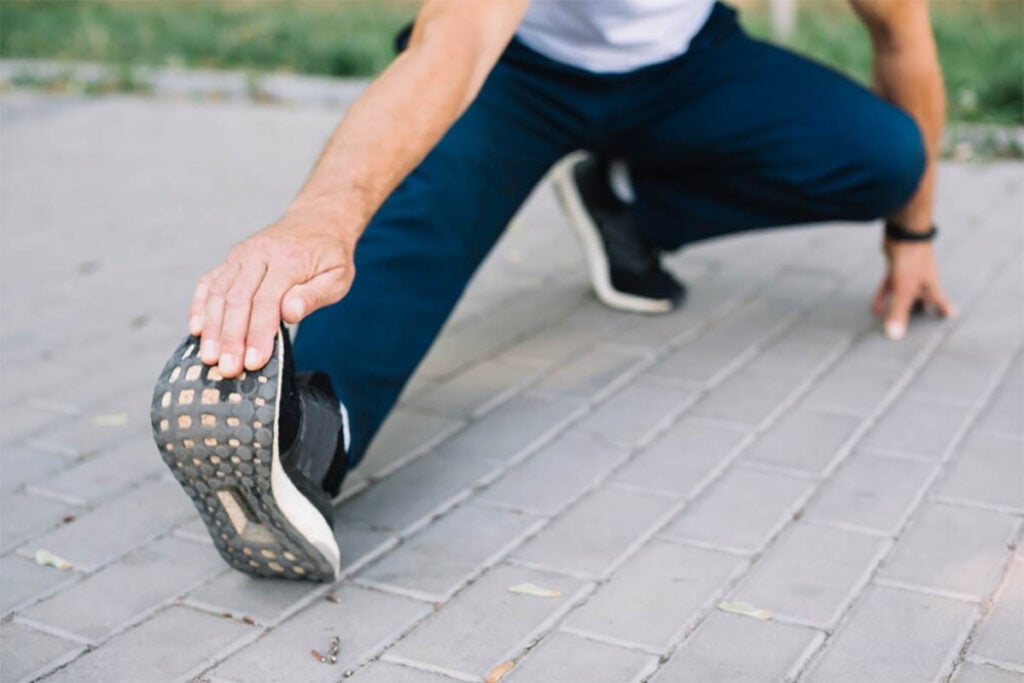Introduction
Running is a popular form of cardio that benefits the heart, lungs, and mental health. However, it’s a high-impact activity that puts significant stress on the leg muscles, connective tissue, and bone tissue. Understanding the fine line between normal post-run discomfort and potential signs of common leg pain after running is essential. This distinction helps runners of all levels—from novice runners to long-distance and experienced runners—maintain their health and prevent the risk of injury.
Leg Pain
What does it feel like?
Leg pain from running can vary greatly; it might be a dull pain that signifies muscle strain, mild pain from tight muscles, or sharp pain indicating something more serious. Runners need to pay attention to the type of pain they’re experiencing, as it can offer clues about its cause.
Types of Leg Pain
Aching
An aching sensation, especially in the calf muscles or quadriceps muscle, often indicates muscle strain or the presence of microscopic tears within the muscle fibers, a common result of vigorous exercise.
Cramping
Muscle cramps, particularly in the gastrocnemius muscle (a part of the calf muscles), may arise from muscle imbalances, dehydration, or mineral depletion. They manifest as sudden, tight pains that make it difficult to move.
Numbness
Numbness in the legs can occur due to reduced blood flow or pressure on blood vessels and nerves. This is less typical but can be exacerbated by conditions like flat feet or exertional compartment syndrome.
Common areas where runners might feel pain
The repetitive impact of running can cause wear and tear on the soft tissues and joints, leading to discomfort in areas such as the knees, shins, and Achilles tendon. This can often leave runners asking, “Why do the insides of my legs hurt when I run?” This type of internal leg pain, particularly after a run, can be due to conditions such as tibial stress syndrome or medial tibial stress syndrome, more commonly known as shin splints.
Novice runners, those with flat feet, or runners with poor technique are particularly susceptible to this kind of running pain. Understanding why your legs hurt after running in specific areas can guide you in adopting preventive measures or seeking appropriate treatment.
Descriptions of Common Injury Spots
Understanding common injury spots, such as the knee joint in knee pain (a common overuse injury), the shin bone in tibial stress syndrome, or the iliotibial band, helps runners identify their pain. This knowledge is crucial for self-assessment and deciding when to seek help from a healthcare provider.
Normal Leg Pain After Running

Muscle soreness
Muscle soreness, particularly in leg muscles like the calf muscles and quadriceps, usually occurs after high-intensity workouts or when introducing new exercises. This is part of the body’s adaptation process, signaling that the muscles are getting stronger.
Why it’s normal?
This type of pain typically arises from microscopic tears in the muscle fibers and connective tissue, which, although sounding alarming, is a normal response to physical exertion as the body works to repair and strengthen the tissue.
How to help normal pain at home
Rest
Allowing your body to rest is crucial. It’s during this time that muscle repair and strengthening occur. Taking breaks from running allows the body to recover and reduces the risk of injury.
Ice
Applying ice to sore muscles can help reduce inflammation and alleviate pain. It’s particularly beneficial for areas like the calf muscles, which can become inflamed from overuse.
Compression
Compression garments aid in reducing swelling and muscle vibration, which in turn, can decrease muscle soreness and speed up recovery.
Elevation
Elevating the legs promotes blood circulation, helping to remove waste products accumulated in the leg muscles after running.
Stretching
Performing stretching exercises for the calf muscles, quadriceps, and hamstrings can relieve muscle tension and enhance flexibility, reducing the risk of pain and injury.
Massage
Massage or foam rolling can help relax tight muscles, improve circulation, and reduce muscle tension.
Signs of Not Normal Leg Pain
Sharp, stabbing, or severe pain
In recent studies, Exertional Lower Leg Pain (ERLP) emerged as the most prevalent among running-related issues, accounting for 32.7% of total injuries observed. Interestingly, it was found that running less than 40 miles per week acts as a protective measure against the spectrum of overuse injuries that runners commonly face.
Sharp or stabbing pain, particularly if it’s sudden and without clear cause, should never be ignored. It could indicate a severe injury such as a muscle tear or bone fracture.
Pain that doesn’t go away or gets worse
Persistent pain, especially pain that intensifies with physical activity or persists at rest, may indicate a serious condition like a stress fracture or tendinitis and warrants an accurate diagnosis by a health care provider.
Swelling, redness, or warmth
These could be signs of inflammation or infection, especially if accompanied by pain. In such cases, it’s essential to seek medical attention to prevent further damage.
Immediate Actions if Severe Pain Occurs
Cease all running and physical activity immediately. Apply ice and elevate the injured area. Consult a physical therapist or health care provider for an assessment and proper treatment plan.
Preventing Leg Pain

Proper Warm-up and Cool-down
A proper warm-up before running and a cool-down after can significantly reduce the risk of leg pain. These should include stretching exercises that target the leg muscles, promoting flexibility and reducing tension.
Gradual Progression
Avoid increasing your mileage or intensity too quickly. Adhere to the 10% rule, where you increase your running volume by no more than 10% each week.
Good Running Form
Maintaining proper running form minimizes unnecessary stress on your legs. Focus on keeping your body weight balanced and your movements fluid.
Appropriate Footwear
Investing in the right running shoes for your foot type can prevent many types of leg pain. Shoes that provide adequate support and fit well can mitigate the impact on your legs.
Hydration and Nutrition
Ensure you drink water before, during, and after running to stay hydrated. A balanced diet aids in muscle repair and growth, reducing the likelihood of cramps and injuries.
Cross-Training
Engaging in low-impact exercises like swimming or cycling can improve overall fitness while giving your legs a break from the constant impact of running.
Adequate Rest and Recovery
Rest days are as important as training days. They allow your muscles to recover and prevent overuse injuries.
Stretching and Foam Rolling
Incorporate stretching and foam rolling into your exercise routine to maintain muscle flexibility and prevent tightness.
Listen to Your Body
Heed the signals your body sends. If you experience pain, take a break and assess whether you need to modify your exercise routine or seek medical advice.
The Importance of Posture and Technique
Good posture and running technique are vital for reducing the risk of injury. Poor running technique can lead to muscle imbalances and increased stress in certain areas, leading to pain and injuries.
Types of Cross-Training Beneficial for Runners
Swimming
An excellent form of cardio, swimming strengthens the muscles without the high-impact stress on your legs, making it a perfect complement to running.
Cycling
Cycling helps build endurance and leg strength while offering a reprieve from the repetitive impact of running.
Conclusion
Leg pain after running is common, but understanding whether it’s a normal part of training or a sign of injury is key to effective and safe running. Implementing preventive measures such as proper warm-up, stretching, and listening to your body can help maintain a healthy and enjoyable running experience.
At Backcountry Physical Therapy, we understand the unique challenges that runners face, from minor discomforts to serious running injuries. Our specialized sports physical therapy services are designed to address your specific needs, helping you recover faster and get back to the trails with confidence. Let us guide you through personalized treatment plans that ensure your running journey is pain-free and enjoyable.
Join us, and let’s tackle those challenges together, stride by stride.
FAQs
How do you get rid of leg pain?
Rest, ice, compression, and elevation are effective immediate treatments. For ongoing pain, incorporating stretching, hydration, and possibly consulting with a physical therapist can provide relief and prevent future pain.
Is it OK to go for a run every day?
Running every day is possible if you’re experienced and if your body can handle the stress. However, for most people, incorporating rest days and cross-training into their exercise routine is essential to prevent overuse injuries.
Can hot water reduce leg pain?
While hot water can relax tight muscles and improve circulation, it’s important to use it in conjunction with other treatments such as stretching and ice for the best results. Always consult with a healthcare provider for persistent leg pain.



